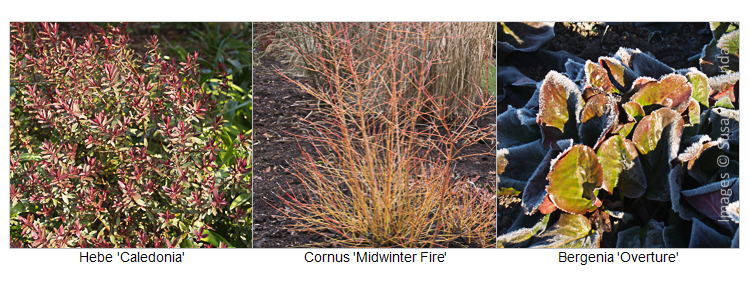In a small garden every plant counts and plants with ‘multi-season’ interest are particularly valuable. Look for plants that offer flowers and fruit, foliage and flowers, or plants that have autumn colour or interesting stems or foliage during winter.
Plants that have both flowers and fruit
These include plants that have the added bonus of foliage interest as well. Berberis forms can really come into their own here, for example the tiny Berberis thunbergii ‘Tiny Gold’ which has yellow leaves, young red shoots, yellow spring flowers and red fruit in autumn. Berberis thunbergii f. atropurpurea ‘Admiration’ has red-orange leaves but is otherwise similar. There is now a range of disease-resistant Hypericum which have yellow flowers and coloured fruits, try Hypericum Magical Beauty = ‘Kolmbeau’ for its berries that start peachy-pink. If you want a good-sized, handsome shrub the fan-shaped, golden-leaved Leycesteria formosa Golden Lanterns = ‘Notbruce’ has red flowers and purple fruits that provide interest all summer through.
Plants that have winter interest
Consider flowering plants with foliage that changes colour in winter. Some Hebes have this quality, coming in a range of sizes and needing a spot that has sunshine in winter. Try the compact Hebe ‘Caledonia’ with violet flowers and rose-purple winter foliage whilst Hebe ‘Pascal’ has copper-red winter foliage. Amongst herbaceous plants Bergenia often have burnished winter foliage, for example Bergenia ‘Overture’ has bright pink spring flowers and leaves that are burgundy in winter. The stems of dogwoods can positively glow in winter sunlight – for beautiful variegated foliage and red stems try Cornus alba ‘Spaethi’ or Cornus sanguinea ‘Midwinter Fire’ for good autumn colour followed by orange winter stems. These are cut back to near ground-level in spring, once established.
Plants with exceptional foliage
Evergreens in particular can provide interest throughout the year. Pittosporum tenuifolium ‘Gold Star’ has dainty shimmering foliage and can be pruned for containment if space is limited. In warm gardens the exotic Coprosma and Lophomyrtus forms, some of which change colour at different seasons, can be fascinating. Try Coprosma repens ‘Tequila Sunrise’ or Lophomyrtus x ralphii ‘Red Dragon’ with red to black foliage. Slow but beautiful Nandina domestica ‘Wood’s Dwarf’ glows red in winter and is gold, green and red in summer. For foliage drama where a feature plant can be accommodated Fatsia japonica ‘Spider’s Web’ is exotic, with huge variegated leaves.
Plants for a hot and dry place
Where your garden has a hot and dry area, herbaceous plants can be invaluable. Slugs permitting, try Alstroemeria, coming in a huge range of sizes and happy in a container, such as Alstroemeria ‘Orange Gem’ Striking Abutilon with big bell-flowers can be grown as annuals, try apricot-flowered Abutilon ‘Linda Vista Peach’. Colourful Zinnias have a long season, if deadheaded, an example being Zinnia marylandica ‘Zahara Yellow’ (Zahara Series) . Sedums also have a place in a hot spot. In winter they provide architectural interest with their flat brown seed heads, try grey purple Sedum ‘Matrona’ . Frothy purple fennel is lovely placed at the rear, especially Foeniculum vulgare ‘Purpureum’ . Requiring little attention Salvias, such as the small shrub Salvia microphylla ‘Pink Blush’ has rich pink flowers for months whilst silvered Convolvulus cneorum is decorative all summer.
This has just dipped a toe into the possibilities. We haven’t even started on walls and fences that can be clad in repeat-flowering climbing Roses paired with Clematis…
Enjoy!
Susan A Tindall



